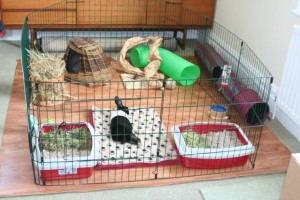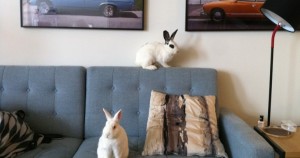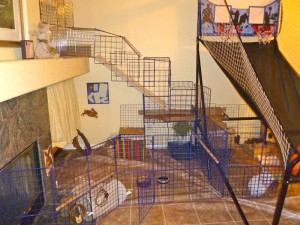
Call us Now ![]() +91-8744012053
+91-8744012053
Mon - Sat ~ 10:00 AM - 6:00 PM
Follow & Like
.png)


Call us Now ![]() +91-8744012053
+91-8744012053
Mon - Sat ~ 10:00 AM - 6:00 PM
Follow & Like
.png)


A rabbit’s environment has a direct link to how healthy and happy it is. Bouncy rabbits are a result of the best diet and living conditions. Living conditions include the pet’s resting place, play area and toilet. Here are top points to consider while setting up an ideal bunny environment inside your house:
Allot a part of some room to your rabbit which is big enough for it to run, hop and stretch. Separate this area from the rest of the room using a puppy pen.

3.Water and food bowls must be properly cleaned before refilling. Remove any uneaten fresh foods that have been lying for a few hours. Image-forums.rabbitrehome.org.uk/
4. Demarcating the bunny’s space with a puppy pen will be helpful in getting it used to its litter box and feeding spot. Rabbits usually choose one spot for the purpose of urinating or pooping and setting up a litter box/tray within the pen will aid in the litter training process. So when your rabbit is roaming outside of its pen it will most likely return to its litter tray for doing its business.

5. Supervise the time your rabbit is roaming freely inside your house outside of its pen. Keep it away from areas where there are electrical wires on which it can get its teeth on.
6. Bunnies are sociable. They enjoy spending time with their humans. They may feel bored or depressed if left alone without opportunities to interact & explore.
7. The room where the bunny is spending most of its time must be well ventilated and not very hot or cold. Extreme temperatures, damp or unclean living conditions are a threat to your rabbit’s well being.
8.The litter box/tray must be lined with shredded newspaper, hay and non-clumping cat litter. The floor of the tray can also be covered with wood shavings. Whatever absorbent material you use, make sure the tray is cleaned once or twice daily. This will also eliminate any urine smell in the room.

9. Clean the pet’s personal space/living quarters daily. A clean housing guarantees a disease free pet.
9. Clean the pet’s personal space/living quarters daily. A clean housing guarantees a disease free pet.
10. Rabbits are prey animals and providing a safe environment to them means they are protected from cats, dogs, birds of prey, ferrets and other predators.
11. Exercising the bunny and allowing it to run, hop and jump off elevated platforms will ensure bone and muscle strength. Lack of exercise could result in weak bones that are susceptible to breakage. Supervise its play time outside of its pen.
12. Gradually increase the space within the pen once the rabbit has gotten accustomed to its litter box and feeding spot. So this way the bunny gets more space to move around within a certain boundary when unsupervised.
13. Remove any indoor plants that may be toxic to the animal especially from areas your rabbit is allowed to roam. Household cleaning agents, human medicines, books, ornaments must be stored in a place your rabbit cannot reach. Cover any open wire with a plastic casing.
14. Offer safe and fun alternatives to direct your rabbit’s attention from something you want it away from. Let it explore and investigate things like sofas and other furniture. However if it tries to chew on these items, stop it each time it tries to nibble on them. Stay consistent in saying ‘No’ till it loses interest in these items you want to protect from its teeth.
15. Places where you don’t want your bunny to sneak in and hide can be blocked using a plywood panel.
16. House plants that aren’t toxic can be placed some place where the bunny can’t visit as it can most likely dig its soil out.
17.When you have to travel for a few days leaving the pet rabbit behind, it is best to arrange for someone who can care for the bunny in your house.Rabbits prefer to stay within a familiar setting.
18.In case you bring in a pet sitter or a relative to care for the pet make sure it is able to meet all the rabbit’s daily needs. Discuss any special requirements your rabbit has with the sitter. Share contact details of the vet/person in case of an emergency medical situation.
19. Rabbit cage as a housing option offers very little space to the bunny to move around. A cage with a wire bottom is very uncomfortable for the bunny to lay or stand on it. It can injure your rabbit’s paws as they do not have enough padding. Using a cage is avoidable even if you plan to house the pet in it for some hours especially when unsupervised through the day.
20. A pen is definitely a better and more comfortable set up for the rabbit.
Housing a pet rabbit in the same space as ours proves to be satisfying not just for the pet but also its owner for the rabbit parent receives round the clock companionship from the fur ball.